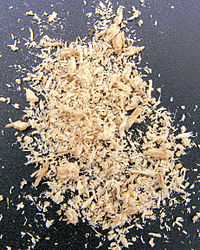
Photo from wikipedia
ABSTRACT We aimed to characterize bakers' personal exposure to airborne flour dust with respect to the health-related aerosol fractions inhalable, extrathoracic, and thoracic dust, and to examine possible production-related determinants… Click to show full abstract
ABSTRACT We aimed to characterize bakers' personal exposure to airborne flour dust with respect to the health-related aerosol fractions inhalable, extrathoracic, and thoracic dust, and to examine possible production-related determinants of dust exposure. Sixty-eight bakers from 7 bakeries in Bergen, Norway (2009–2012) participated in the exposure assessment, comprising full-shift personal samples of inhalable dust (n = 107) and thoracic dust (n = 61). The relation between possible determinants and exposure was estimated using mixed effects models, while associations between the various aerosol fractions across task groups and type of bakeries were described by Pearson's correlation coefficients. Bakers' overall geometric mean personal exposure to inhalable, extrathoracic, and thoracic dust were 2.6 mg/m3 (95% CI: 2.0, 3.2), 2.2 mg/m3 (95% CI: 1.9, 2.7), and 0.33 mg/m3 (95% CI 0.3, 0.4), respectively. A total of 29% of the measurements of inhalable dust were above the Norwegian Occupational Exposure Limit of 3 mg/m3. The exposure variability of inhalable dust could not be explained by any of the examined production-related determinants, while the daily production volume explained 18% of the variance in thoracic dust exposure. Overall, the thoracic dust represented 15% of the inhalable dust, being rather stable across the production-related determinants. The overall correlation between inhalable and thoracic dust was nevertheless moderate (r = 0.52, p < 0.001), with the highest correlation for craft bakers (r = 0.62) and no correlation during dough forming (r = 0.01). Bakers are exposed to flour dust at a level that most likely represents an excess risk of developing chronic diseases of the respiratory system, and a decrease of present exposure level is imperative. Extrathoracic dust—likely the most relevant sub-fraction in respect to flour-induced sensitization and occupational rhinitis—represented the main proportion of the measured inhalable dust. The variation in correlation coefficients between the dust fractions across bakery types and task groups underlines the need of more knowledge about how these aerosol fractions are distributed across the production process and bakery types.
Journal Title: Journal of Occupational and Environmental Hygiene
Year Published: 2017
Link to full text (if available)
Share on Social Media: Sign Up to like & get
recommendations!